Katherine Langrish's Blog, page 42
October 14, 2011
Mystical Voyages (5) Jason and the Argonauts
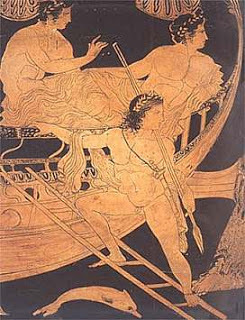
Although I said that the Odyssey was the grand-daddy of voyage stories, perhaps I was rash, for the story of Jason and the Argonauts is just as old and maybe even older. We know this because Homer clearly expected his audience would be familiar with it. In Book 12 of the Odyssey, when Circe is advising Odysseus and his men how to avoid the Clashing Rocks, she says:
…against themcrashes the heavy swell of dark-eyed Amphitrite…That way the only sea-going ship to get through was the Argo,who is in all men's minds, on her way home from Aeetes;and even she would have been driven on the great rocks that time,but Hera saw her through, out of her great love for Jason.
But the only full remaining account of Jason's adventures is the 'Argonautika' by Apollonius of Rhodes, written in the mid 3rd century BC and clearly a 'literary' achievement, while the Odyssey, like the Iliad, dates from the late 8th century BC - so I tend to think of Jason as coming later. (Add the fact that Homer's Iliad and Odyssey refer to events of the Bronze Age in the early 12th century BC, and I don't know about you, but I begin to feel giddy with all this gazing into the dark backward and abysm of time.)
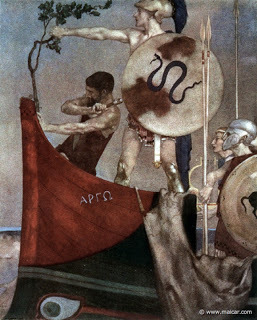 I rather like the story that Apollonius wrote the first draft of the Argonautika as a very young man, and it got terrible reviews. Undeterred, he moved from Alexandria to Rhodes, rewrote the poem, and finally published it to great critical acclaim - a story which demonstrates the importance of resilience (and revision) for writers of all eras!
I rather like the story that Apollonius wrote the first draft of the Argonautika as a very young man, and it got terrible reviews. Undeterred, he moved from Alexandria to Rhodes, rewrote the poem, and finally published it to great critical acclaim - a story which demonstrates the importance of resilience (and revision) for writers of all eras! Anyway, as everyone knows, the Argo was built to carry Jason and his band of fifty heroes (including Hercules, Hylas, Orpheus, and the twins Castor and Pollux) all the way from Thessaly to Colchis, Georgia, in search of the Golden Fleece. Argo herself was a prophetic ship with her own voice, for a beam of the sacred oak of the oracle of Zeus at Dodona had been built into her.
Jason wept as he turned his eyes away from the land of his birth. But the rest struck the rough sea with their oars in time with Orpheus' lyre, like young men bringing down their quick feet on the earth in unison with one another and the lyre, as they dance for Apollo round his altar at Pytho… On either side the dark salt water broke into foam, seething angrily in answer to the strong men's strokes. The armour on the moving ship glittered in the sunshine like fire, and all the time she was followed by a long white wake which stood out like a path across a green plain.
Can't you just smell the salt? I love this vigorous, stirring passage. It's so clearly an account by someone who has often seen these very things.
As in all these mystical voyages, the Argo island-hops to her destination – reflecting the real-life practice of ancient ships which rarely spent long out of sight of land. The heroes head first for Lemnos in the Northern Aegean, where the women of the island have recently murdered all their menfolk and greet the Argonauts as useful breeding partners to repopulate the island. From thence the Argo passes the Hellespont and heads into the Sea of Marmara, making landfall at Cius in Bythynia (northwest Turkey) where Hercules' companion, the youth Hylas, is drowned by a nymph as he goes to fetch water:
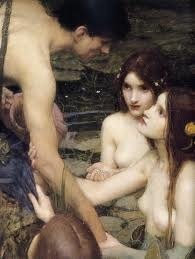
The naiad of the spring was just emerging as Hylas drew near. And there, with the full moon shining on him from a clear sky, she saw him in all his radiant beauty and alluring grace. Her heart was flooded by desire… Hylas now leant over to one side to dip his ewer in, and as soon as the water was gurgling loudly round the ringing bronze she threw her left arm round his neck in her eagerness to kiss his gentle lips. Then with her right hand she drew his elbow down and plunged him in midstream.
Terribly upset, Hercules abandons ship at this point and the Argo sails on without him. At the Bosphorus, the Argo encounters the Harpies and the Clashing Rocks till, finally arriving at Colchis, Jason wins the Golden Fleece with the aid of the witch princess Medea. Jason's protectresses, the goddesses Hera and Athene, bribe little Eros to shoot one of his arrows at Medea, ensuring she falls in love with their protégé. In the charming passage where they beg Eros' mother Aphrodite to assist them, she responds:
"He is far more likely to obey you than me. There is no reverence in him, but faced by you he might display some spark of decent feeling. He certainly pays no attention to me… I am so worn out by his naughtiness I have half a mind to break his bow and wicked arrows in his very sight, remembering how he threatened me with them in one of his moods. He said, 'If you don't keep your hands off me while I can still control my temper, you can blame yourself for the consequences."
Hera and Athene smiled at this and exchanged glances.
Transfixed by Eros' arrow, Medea has no choice. She falls in love and shows Jason how to pass (and survive) the three tests set by her father King Aeetes: to harness bulls with bronze hooves, to plough the field of the war god Ares, and to sow the dragons' teeth which turn into an army of warriors. Finally, as King Aeetes still refuses to part with the Fleece, Medea uses her herbal skills to put to sleep the dragon which guards the Fleece.
It seems likely the legend of the Fleece itself sprang from the ancient Georgian practice of using sheep fleeces submerged in running streams to collect particles of gold, and this may be reflected in a sentence from one of Pindar's odes which describes 'the fleece, glowing with matted skeins of gold' (trans: Nigel Nicolson). But in the Argonautika it takes on a much more magical appearance:
Lord Jason held up the great fleece in his arms. The shimmering wool threw a fiery glow on his fair cheeks and forehead and he rejoiced in it, glad as a girl who catches on her silken gown the lovely light of the full moon as it climbs the sky and looks into her attic room. …The very ground before him as he walked was bright with gold.
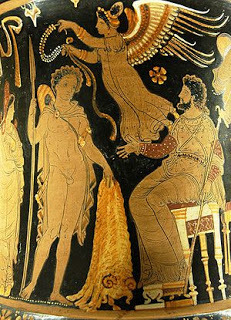
Jason and Medea escape together on the Argo, and eventually return to Thessaly, avoiding the Sirens and helped through the Clashing Rocks by sea nymphs who:
… holding their skirts up over their white knees, began to run along on top of the reefs and breaking waves, following each other on either side of the ship. Argo, caught in the current, was tossed to right and left… but the Nereids, passing the ship from hand to hand and side to side, kept her scudding through the air on top of the waves. It was like the game which young girls play beside a sandy beach, when they roll their skirts up to their waists on either side and toss a ball round to each other, throwing it high in the air so that it never touches the ground.
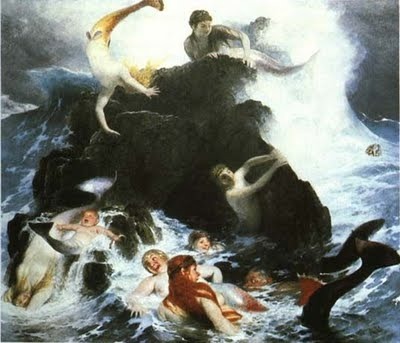
Isn't that lovely? Old as the story of Jason may be, this later telling of Apollonius often feels light, sophisticated and playful. But the voyage across the sea to Colchis, and the journey into the sacred, dragon-or-serpent-guarded grove has a resonance that has lasted down the ages. And Medea is Circe's niece, a priestess of Hecate, goddess of childbirth, death, necromancy, doorways and crossroads, magic, torches and dogs. In keeping with this, Medea is an often ruthless figure of great power, who near the end of the Argonautika calls on the spirits of death, the hounds of Hades, to slay the bronze giant Talos. In other versions of her legend, she is the owner of a magical cauldron which can restore life to the dead (something which will turn up in Celtic mythology too: see next week's post). She poisons her rivals and murders her own children. The voyage of Jason to the land of the Golden Fleece and his meeting with Medea, giver of life and death, seems to suggest that his too is an Otherworld journey.
The quotation from the Odyssey in this post is from the translation by Richmond Lattimore, Harper Torchbooks, 1965The quotations from the Argonautika are from the Penguin translation by E.V. Rieu
Picture credits: The Argo and Argonauts - red-figure Greek vase
Building of the Argo - William Russell Flint Hylas and the Nymphs - John WaterhouseJason and the Golden Fleece - Apulian red-figure kraterNaiads Playing - Arnold Böcklin
Published on October 14, 2011 00:56
October 10, 2011
Mystical Voyages (4) The Sirens
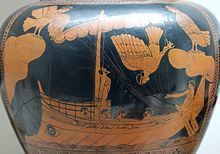 The sirens were originally young girls, the friends of Persephone, who were changed into birds with girls' faces after she was abducted by Hades. Of course, this means they are the companions of the powerful goddess of death, and their irresistable song will take your spirit into the Otherworld (while your body lies lies rotting in their meadow full of bones).
The sirens were originally young girls, the friends of Persephone, who were changed into birds with girls' faces after she was abducted by Hades. Of course, this means they are the companions of the powerful goddess of death, and their irresistable song will take your spirit into the Otherworld (while your body lies lies rotting in their meadow full of bones).So this quick post is another poem. This is one of mine: and it's the only poem I ever wrote which - rather than being consciously composed - seemed to come to me through the ether, as though I were listening to a very faint voice on a distant radio and trying to make out the words.
It's also from a long time ago, when I was having an internal discussion with myself about whether I should be writing fantasy... (Was fantasy 'serious'? Wasn't it rather frivolous - derivative - escapist? Was it something that leached energy from reality, rather than enhancing it? I wanted to write fantasy, but I worried about it.)
Then this poem arrived and informed me direct from the muse that it didn't matter whether I worried or not. I have no choice about it. I write what I am compelled to write, and there really is no escape...
If you try to jump ship, you merely drown.
Ulysses
'Come here, young man,' the siren sings
from her unfaithful rock.
The knowledgeable dreamer
closes his crew's ears to the ringing sound,
but, all the summer, hears across the water
the cheated music slide
after his ship: 'Come back...'
There is no escaping from the experience.
Presently he approaches the cave-riddled land
of Giant One-Eye,
whose log-wide gaze
the dreamer is, of course, clever enough to burn out
but cannot help his friends, being No Body.
They were dreams, anyway.
With inevitable luck,
the boulder smashing into the sea misses him -
and so it goes on. On Circe's smoke-wrapped island
he is protected
by a magic herb,
but is permanently changed, unlike his comrades:
she saved her subtler incantations for him.
And so, on waking -
having reached home safely -
he finds that he is still a prisoner,
and all his clever tricks of touching wood,
crossing his fingers, tongue in
cheek during promises,
never fooled or hindered anyone at all.
At home now in the factual world he finds
his dream unbreakable.
'Come here, young man. Come here,
sailor, bold sailor,' impossible voices call.
Copyright Katherine Langrish 2011
Picture credits: Odysseus and the Sirens, British Museum vase
Published on October 10, 2011 01:06
October 7, 2011
Mystical Voyages (3) The Old Ships

A couple of quick ones this week. Two poems, in fact. Here's the first, and the second will be up just after the weekend.
I remember coming across this poem in a school anthology, and it's stayed with me ever since. You probably know it too, but it's well worth reading again. It references not only the tale of Odysseus, but a story about Dionysos, god of wine and ecstasy. Once, sitting on the seashore in the form of a beautiful youth, he was kidnapped by sailors who dragged him on board their ship, intending to sail away and sell him into slavery. This turned out to be an extremely bad move - never kidnap gods! - for as they raised the sail, Dionysos caused vines to spring up all over the ship, twining up the mast and tangling the oars so that they could not move. Then he turned himself into a fierce lion and killed everyone on board, except for the helmsman who had pleaded for him, and those terrified sailors who had jumped into the sea, whom he transformed into dolphins. The story is depicted above by the painter Exekias in black-figure on the interior of a kylix, a shallow two-handled bowl for drinking wine.
'The Old Ships' by James Elroy Flecker I have seen old ships sail like swans asleep Beyond the village which men still call Tyre, With leaden age o'ercargoed, dipping deep For Famagusta and the hidden sun
That rings black Cyprus with a lake of fire;
And all those ships were certainly so old - Who knows how oft with squat and noisy gun, Questing brown slaves or Syrian oranges,The pirate Genoese Hell-raked them till they rolled Blood, water, fruit and corpses up the hold.
But now through friendly seas they softly run, Painted the mid-sea blue or shore-sea green, Still patterned with the vine and grapes in gold.
But I have seen, Pointing her shapely shadows from the dawn And image tumbled on a rose-swept bay, A drowsy ship of some yet older day; And, wonder's breath indrawn, Thought I - who knows - who knows - but in that same (Fished up beyond Aeaea, patched up new - Stern painted brighter blue -) That talkative, bald-headed seaman came (Twelve patient comrades sweating at the oar) From Troy's doom-crimson shore, And with great lies about his wooden horse Set the crew laughing, and forgot his course.
It was so old a ship - who knows, who knows? - And yet so beautiful, I watched in vain To see the mast burst open with a rose, And the whole deck put on its leaves again.
Published on October 07, 2011 00:56
September 30, 2011
Mystical Voyages (2) Odysseus
'Push off, and sitting well in order smiteThe sounding furrows; for my purpose holdsTo sail beyond the sunset, and the bathsOf all the western stars, until I die.It may be that the gulfs will wash us down:It may be we shall touch the Happy IslesAnd see the great Achilles, whom we knew…'
So speaks the aging Ulysses to his companions in Tennyson's great poem. Unwilling 'to rust unburnished' and die by his own hearth, he sets out actively to seek the lands beyond the sunset, the home of the heroic dead.
But the voyages Odysseus makes in the Odyssey have already taken him alive into the Otherworld – to many a magical island ruled by nymphs and goddesses, and at last to the very shores of death. At the beginning of the Odyssey, the gods are discussing the latest news from Mycenae, where Orestes has just struck down Aegisthus, his father's killer. Zeus complains that men blame the gods for their misfortunes, when in reality they bring troubles upon themselves. But Athene takes the opportunity to put in a plea for her own protégé Odysseus:
Aigisthus indeed has been struck down in a death well-merited.…But the heart in me is torn for the sake of Odysseus,unhappy man, who still, far from his friends, is sufferinggriefs, on the sea-washed island, the navel of all the waters,a wooded island, and there a goddess has made her dwelling-place.

This goddess is the nymph Calypso, who
…detains the grieving, unhappyman, and ever with soft and flattering words she works tocharm him to forget Ithaka; and yet Odysseusstraining to get sight of the very smoke uprisingfrom his own country, longs to die.
Zeus agrees that it is indeed time to work on bringing the hero home.
The story of Odysseus is the grand-daddy of legendary voyage stories. Setting off from Troy with twelve ships, he and his men are driven by storms to the land of the Lotus Eaters (whose fruit causes memory-loss) and then the island of the Cyclops Polyphemus, who captures them for food 'like killing puppies' and from whom they escape after blinding him. Still grieving for their dead comrades, they make their next landfall at
…the Aiolian island where Aioluslived, Hippotas' son, beloved by the immortalgods, on a floating island, the whole enclosed by a rampartof bronze…
Aiolus is in charge of the winds and gives Odysseus a leather bag holding all except the west wind – a gift which properly used should have carried the hero home. But while Odysseus sleeps his men open the bag, and all the winds burst out and drive them back on their course. Aiolus refuses to help them again, and, entering the harbour of the cannibal Laistrygonians, all Odysseus' ships are destroyed except his own:
My ship and only mine, fled out from the overhangingcliffs to the open water, but the others were all destroyed there.
Next:
We came to Aiaia, which is an island. There lived Circeof the lovely hair, the dread goddess who talks with mortals.
Circe changes Odysseus' remaining companions into swine, but, aided by Hermes who gives him the magical herb moly, Odysseus rescues them and becomes Circe's lover. Finally, Circe advises them to sail to Hades, land of the dead, to consult the spirit of the seer Tiresias. Deeply shaken by this advice, Odysseus demands,
'who will be our guide on that journey? No onehas ever yet in a black ship gone all the way to Hades.'
But the goddess tells him to raise sail and:
…let the blast of the North Wind carry you.But when you have crossed with your ship the stream of Ocean, you willfind there a thickly wooded shore, and the groves of Persephone,and tall black poplars growing, and fruit-perishing willows,then beach your ship on the shore of the deep-eddying Ocean. And yourself
go forward into the mouldering home of Hades.
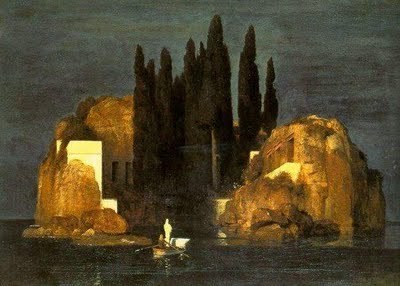
Odysseus meets many spirits of the dead here, including his own mother, whom he vainly attempts to embrace:
…three times I started towards her, and my heart was urgent to hold her,and three times she fluttered out of my hands like a shadowor a dream, and the sorrow sharpened at the heart within me.
And Achilles, whom he tries to console with news of his earthly fame, only to receive the bitter reply:
I would rather follow the plough as thrall to anotherman, one with no land allotted to him and not much to live onthan be king over all the perished dead.
This, from the Achilles of the Iliad who chose glory instead of length of days, shows how very different the mood of the Odyssey is from that of the Iliad…
Returning to Circe's island, Odysseus and his men are given further advice about their homeward voyage. They skirt the island of the sweetly-singing Sirens who tempt sailors on to the rocks, and pass the monster Scylla and the whirlpool Charybdis. Then the ship is wrecked (as punishment for hunting the cattle of the sun god Helios), and Odysseus is the only survivor. He is washed ashore on the island of the nymph Calypso, who keeps him as her lover for seven years until Zeus orders her to release him…
For me, one of the most fascinating things about the Odyssey is the prevalence of powerful women, beside whom Odysseus is simply a homeless wanderer. There are the nymphs Calypso and Circe, the female monsters Scylla and Charybdis, the goddesses Persephone and Athene, the Sirens, the princess Nausikaa who rescues Odysseus after his second shipwreck, and her mother Queen Arete whom Nausikaa advises Odysseus to approach first rather than her father King Alkinous. There is wise Penelope, Odysseus' wife: clearly queen in her own right since marriage to her will give one of the suitors kingship. There's even Odysseus' old nurse, who is the first person to recognise him on his return to Ithaka. And there's Odysseus' longing to embrace his beloved mother in Hades. It's so different from the warlike world of the Iliad in which women – Chryseis, Briseis, Andromache, Helen, Cassandra – are powerless victims. No wonder Robert Graves suggested in his novel 'Homer's Daughter' that the Odyssey was written by a woman!
But most of all, the Odyssey sets the pattern for the Mystical Voyage, which takes the protagonist from one magical island to another, encountering mystery, danger and wonder. The island sealed with brazen walls, the island surrounded by whirlpools, the island of the winds, the dark shore of Death with its black poplars and whispering willows, all these will recur and echo down the centuries.
All quotations from the Odyssey in this post are from the translation by Richmond Lattimore, Harper Torchbooks, 1965
Picture Credits:Odysseus and Calypso by Arnold BocklinThe Island of the Dead by Arnold Bocklin
Published on September 30, 2011 00:09
September 23, 2011
Mystical Voyages (1) Of Ships and Suns
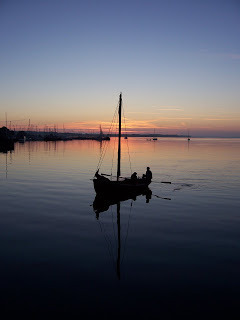
In all kinds of mythologies there are stories about sailing across the sea to a mystical land. Maybe peoples of all races and all times have this in their blood: anyone who's ever stood at the seashore and seen the sun rising or setting over the ocean must have wondered, like my hero Peer Ulfsson in 'West of the Moon' what it would be like to find the lands beyond the sun:
He clambered across the cargo and up the curve of the ship into the stern, where he stood for a moment holding the tiller and gazing out westwards. The sun was low, laying a bright track over the water: a road studded with glittering cobblestones. It stung his heart and dazzled his eyes.
He felt a surge of longing. Life was a tangle that tied him to the shore. What would it be like to cut free, shake off the land, and go gliding away into the very heart of the sun?
That ships and suns go together can be seen from the Egyptian sun god Re with his two boats: the sun boat or Mandjet (Boat of Millions of Years) which carried him from east to west across the sky accompanied by various other deities and personifications, and the night boat, the Mesesket, on which the god travelled through the perilous underworld from west to east, to rise again in the morning.
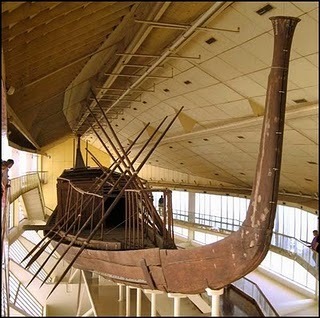 How old is Re? Well, judging by the dates of temples dedicated to his worship, his cult rose to its zenith in the 5th Dynasty, beginning approximately 2500 BCE. The dead were expected to spend eternity travelling with him across the sky. (Later his cult was superseded by the resurrection cult of Osiris.) The photo above this paragraph shows the full-size Egyptian ship known as the Khufu ship, 143 feet long and built of Lebanon cedar, which was sealed into a pit at the foot of the Great Pyramid of Giza: the remains of many other solar boats have been found in different locations in Egypt.
How old is Re? Well, judging by the dates of temples dedicated to his worship, his cult rose to its zenith in the 5th Dynasty, beginning approximately 2500 BCE. The dead were expected to spend eternity travelling with him across the sky. (Later his cult was superseded by the resurrection cult of Osiris.) The photo above this paragraph shows the full-size Egyptian ship known as the Khufu ship, 143 feet long and built of Lebanon cedar, which was sealed into a pit at the foot of the Great Pyramid of Giza: the remains of many other solar boats have been found in different locations in Egypt.  Rock engravings in Scandinavia, dated to the Bronze Age any time between 1500 and 400 BCE show the same correspondence between ships and suns. Here are some examples, reproduced in 'The Chariot of the Sun and other Rites and Symbols of the Northern Bronze Age' by Peter Gelling and Hilda Ellis Davidson, showing ships embellished with sun discs and spirals.
Rock engravings in Scandinavia, dated to the Bronze Age any time between 1500 and 400 BCE show the same correspondence between ships and suns. Here are some examples, reproduced in 'The Chariot of the Sun and other Rites and Symbols of the Northern Bronze Age' by Peter Gelling and Hilda Ellis Davidson, showing ships embellished with sun discs and spirals. But people have been heading out to sea for literally hundreds of thousands of years. Here's a link to an article which seems to show that even before we were modern humans, hominids such as homo erectus 'used rafts or other seagoing vessels to cross from Northern Africa to Europe' – island-hopping as they went and leaving stone hand axes on Crete dating to at least 130,000 BCE. How amazing – how utterly mind-blowing is that? Modern humans crossed to Australia 60,000 years ago, and to North America earlier than 13,000 BCE.
Whatever drove them to make these discoveries? A nomadic hunter-gathering lifestyle is one thing: but setting off in a boat or on a raft on a one-way trip into an unknown ocean is quite another, especially with no population pressure pushing you on. I can't help but wonder if there was there a religious, a mystical element to these early voyages of discovery. Maybe, standing on the sea shore, gazing at the sun rising or setting (depending which side of which continent they were), early peoples believed themselves to be embarking on journeys to follow the sun to the land of gods and the happy dead?
And those left behind, watching them depart, must have felt a huge sense of awe, wonder and mystery about what befell the seafarers. As it says in 'Beowulf', when the dead king Scyld Scefing is set adrift in his ship-funeral:
Then they set up / the standard of goldHigh over head: / let the sea bear him:Gave him to the flood / with sad heartsAnd mourning minds. / Men cannotSay for certain, / neither court-counsellorsNor heroes under heaven, / who received that cargo.
Who received that cargo? By the time the Beowulf poem was written down, England was Christian. But the poem leaves us in doubt as to the eventual supernatural landfall of a pagan king: it was an age which could still hold Christian and pagan beliefs in relatively comfortable simultaneity – an age which, maybe, knew it didn't have all the answers.
And people down the centuries have been buried in ships, like the Anglo-Saxon Sutton Hoo ship, dating from the early 7th century AD, and the Oseberg ship, circa 800 AD, which carried the bodies of two women, priestesses or queens, and the Gokstad ship, built of oak felled around 890 AD, sheltering the body of a man, perhaps a king. The 10th century Muslim traveller Ibn Fadlan wrote an eyewitness account of a Viking ship-funeral in Russia: a chieftain interred in his ship along with many grave goods and sacrifices, including that of a slave girl who 'saw' into the land of the dead in a kind of drugged trance, after which she was strangled and stabbed and laid beside him to accompany him on his mystical voyage. According to Ibn Fadlan's account, she had voluntarily offered herself as the sacrifice, and we needn't be too sceptical. In all probability she utterly believed she would be accompanying her lord to the Otherworld. He was her passport to immortality.
So ships and suns and voyages into the west have been part of the human imagination for many thousands of years. After Re the sun god, there came Odysseus, Jason, Maelduine, Brendan, Oisin and many a nameless adventurer with them. There came the Christian hermits who sailed out to remote islets in the Atlantic, and the saints who founded monasteries on Holy Islands like Iona and Lindisfarne. And for the next few weeks, I'm off to explore some of these tales of mystical voyages.
So let's set sail for the western isles, the land of the gods, the land of the dead, the land of the ever-young. Bid farewell to Middle-Earth. This way to Aeaea, Avalon, Tir na n'Og, Valinor, Eldamar, the Hesperides and Hy Brasil. Hush! Can you hear the seagulls crying?
Picture credits: Sunset over Roskilde fjord, Katherine Langrish 2005 The Khufu ShipShip and sun symbols: 'The Chariot of the Sun' by Peter Gelling & Hilda Ellis Davidson
Published on September 23, 2011 08:00
September 18, 2011
AFTER - coming in 2012
A little preview - a little taster -
The table of contents for the forthcoming Datlow and Windling YA dystopian anthology, 'AFTER' which will be published in the United States by Hyperion in 2012.
I'm so, so thrilled to be included in this company - just look at them! I can hardly wait to read the other stories...
Introduction
The Segment by Genevieve Valentine
After the Cure by Carrie Ryan
Valedictorian by N.K. Jemisin
Visiting Nelson by Katherine Langrish
All I Know of Freedom by Carol Emshwiller
The Other Elder by Beth Revis
The Great Game at the End of the World by Matthew Kressel
Reunion by Susan Beth Pfeffer
Faint Heart by Sarah Rees Brennan
Blood Drive by Jeffrey Ford
Reality Girl by Richard Bowes
Hw th'Irth Wint Wrong by Hapless Joey @ homeskool.guv by Gregory Maguire
Rust With Wings by Steven Gould
The Easthound by Nalo Hopkinson
Gray by Jane Yolen
Before by Carolyn Dunn
Fake Plastic Trees by Caitlin R. Kiernan
You Won't Feel a Thing by Garth Nix
The Marker by Cecil Castellucci
The table of contents for the forthcoming Datlow and Windling YA dystopian anthology, 'AFTER' which will be published in the United States by Hyperion in 2012.
I'm so, so thrilled to be included in this company - just look at them! I can hardly wait to read the other stories...
Introduction
The Segment by Genevieve Valentine
After the Cure by Carrie Ryan
Valedictorian by N.K. Jemisin
Visiting Nelson by Katherine Langrish
All I Know of Freedom by Carol Emshwiller
The Other Elder by Beth Revis
The Great Game at the End of the World by Matthew Kressel
Reunion by Susan Beth Pfeffer
Faint Heart by Sarah Rees Brennan
Blood Drive by Jeffrey Ford
Reality Girl by Richard Bowes
Hw th'Irth Wint Wrong by Hapless Joey @ homeskool.guv by Gregory Maguire
Rust With Wings by Steven Gould
The Easthound by Nalo Hopkinson
Gray by Jane Yolen
Before by Carolyn Dunn
Fake Plastic Trees by Caitlin R. Kiernan
You Won't Feel a Thing by Garth Nix
The Marker by Cecil Castellucci
Published on September 18, 2011 03:53
September 16, 2011
'Bloodstone' by Gillian Philip
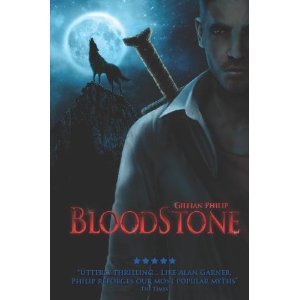
Gillian Philip's first YA fantasy, 'Firebrand', was one of the best books I read last year. I talked about it in my introduction to Gillian's Fairytale Reflection on Tam Lin. Set in the 16th century at a time of witch hunts and burnings, it followed the fortunes of Seth MacGregor, feral prince of the Sithe, the Scots faeries, charismatic and difficult. The Sithe are ruled by a cruel and devious queen, Kate NicNiven. There's a protecting Veil between the land of the Sithe and the mortal world, and Kate wants to tear it away. To do so, she invokes the help of some hauntingly unpleasant creatures called the Lammyr – stretching the loyalty of Seth and his beloved brother Conan almost to breaking point. The book is dramatic, beautifully written, and rooted in the folk and faerie lore of Scotland.
Now here at last is the sequel (second in a series of four): 'Bloodstone'. And - surprising, yet the traditional penalty for those who spend time in Elfland – we find four hundred years have passed. It was a brave move to place Seth and Conan in the 21st century, and it works. Banished from their faerie homeland until they can find the mysterious Bloodstone, they have had to endure long centuries beyond the Veil – parted, except for the occasional illicit foray, from all they hold dear. On one such brief mission, the death of a comrade leaves Seth and Conan guardians of his baby daughter Finn, who is brought up in the human world unaware of her Sithe blood. Then Seth embarks on an ill-fated romance with a mortal woman, earning deep resentment from her young son, Jed. And Kate is still scheming, and the Bloodstone is about to return…
"Bloodstone" is a complex, dramatic and rewarding book – always vivid and fast-moving, but with a lot going on. Rather like her hero Seth, Gillian Philip expects readers to keep up. If your attention does stray, it's possible to get a little lost, but hey – it's nice not to be treated like an imbecile. It's also very nice to read a book about faeries in which the plot is not focussed on a romance between impossibly gorgeous doomed teenage lovers.
Four hundred years of exile have taken their toll on the characters. Still sexy and sarcastic, Seth - dressed in jeans and T-shirt, mouth full of modern slang - has become harder, more difficult, more self-torturing. Responsible Conan is loving and honourable, but also weary and explosive. Young Finn is angry too, and so is Jed – and as they all take it out on one another by turns, there are sometimes possibly a few too many warring temperaments. Nevertheless the story swept me along like a river in spate. The first person narration is brilliantly characterised: as here in Seth's description of young Finn:
"A surly little thing with pale protuberant eyes, she reminded me of a deep-water fish. The older she grew, the more I tended to think of a Moray eel, lurking in darkness, shy and alone, hiding lethal teeth. And let me tell you, you haven't felt native hatred till you've seen it in the eyes of a six-year-old."
There are all sorts of mysteries lurking in the shadows. I love the savage waterhorses which Conan and Seth both ride, and I love the Selkyr, the seal people, sinister and beautiful and wholly Other. This passage on an abandoned moonlit beach had shivers running down my spine:
The black-bellied waves were fringed with phosphorescence, and against their light was a figure: too tall, too lanky to be Leonora, hunched into a long coat with an upturned collar. The coat that was no coat moved and glistened like a wet pelt. The creature wearing it turned, and I sucked in a cold salty breath.
And it just gets better. I'm looking forward very much to the next in the series. And in one of the best compliments I've ever been paid, Gillian has used a verse from my poem 'Janet Speaks' as the epigraph to the book:
Oh Queen of Fays -If I had known of this day's deed -I would have let your knight, Tam LinRide down to Hell on his milk-white steed.
(You can find the whole poem on the new page in the tabs - and next week I'm beginning a new series.)
Published on September 16, 2011 01:16
September 9, 2011
Black Swans
Every now and then you come across a book that's just different. It might be a one-off by an author who puts everything she or he has to say into a single creative burst – or it may be something that stands out from a writer's other work like a black swan in a white flock. Especially in the latter case, such books often don't get the attention they deserve. Perhaps they simply puzzle the author's faithful followers. They can't be categorized. They come out of nowhere and don't seem to lead anywhere. The easiest thing to do is – not to talk about them.
But they tend to be memorable.
Here are three examples, all fantasies, all written by highly talented and in some cases famous children's writers – and none of them, I suggest, as well known as they deserve to be.
A Dark Horn Blowing by Dahlov Ipcar (Macdonald 1978)

I hope and believe that some of you will have read this book (because so far in my life I have met only one other person who has). It's based on an old ballad called The Queen of Elfan's Nourrice , in which a mortal woman, stolen to be nurse to the Queen of Elfland's son, laments for her own child from whom she was taken when he was only four nights old:
I heard a cow low, a bonnie cow lowAn' a cow low down in yon fauld;Lang, lang will my young son greetOr his mither take him frae cauld…
Ipcar's book opens with the sound:
I heard a cow lowing, lowing low on the lea – a mournful sound, full of calling. It called me as I stood there at the window listening in the warm twilight of October.
Eben said, "Come to bed, Wife."
But the enchantment is already working. As her husband falls asleep, Nora steals out into the night, leaving her four day old son wailing in the cradle, down through the wet fields to the shore.
A cow's lowing is a sad sound – I had always thought so – but this was more than that. There were words crying in the sound. Almost a song:
Come Nora!Come Nora!You must come!You must come with me!You must come nurse the Erl PrinceIn a kingdom low by the sea.
…It was a small man with a horn, standing by a long black boat there at the edge of the tide. But I never knew when it was that I first saw him, or when he first spoke. The cow's lowing became the dark horn blowing, and then it was too late…
Full, full of enchantment, this tale – told by various voices – follows the path of Nora, trapped in the Erl Queen's kingdom, her husband Eben who believes she has drowned, her son Owen, raised by the only woman his father can find to feed him – the witch Bab Magga, and Eelie, the Erl-Prince himself.
Dahlov Ipcar the author, who was born in 1917, is an artist who has written and illustrated many other books for children. She currently lives in Maine and is still painting. You can see examples of her work at her website here. I don't believe her other three YA novels are in print, but I would love to read them.
Second of my three examples is Seaward by Susan Cooper (Bodley Head 1983, Puffin 1985)
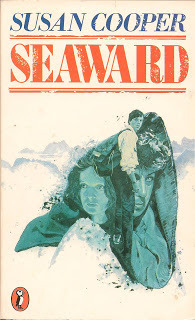 Though Susan Cooper is best known for 'The Dark Is Rising' sequence of YA novels, in my opinion 'Seaward' outshines them all. It's simply one of the strangest, most haunting fantasies I've ever read.
Though Susan Cooper is best known for 'The Dark Is Rising' sequence of YA novels, in my opinion 'Seaward' outshines them all. It's simply one of the strangest, most haunting fantasies I've ever read.
After his mother is killed, a boy called Westerly goes travelling seawards through a mysterious world to find his father - while Cally is a girl whose parents, one after the other, have left her, heading west to the sea themselves in a car driven by a mysterious woman with silver hair. And then Cally begins to hear singing in the empty house… 'rhythmic waves of melody repeated again and again.' The voice sounds like her mother's, but no one else can hear it.
Cally washed, pulled on a shirt and some jeans, went back into her parents' room – and then all at once the singing was back… changed… to a pattern of hammer-blows, beating at her ears. Cally wheeled about, her hands up in defence, terrified.
"Ma! Ma!"
It was instinctive, a cry for help. Where are you? I need you, I don't know what to do, where have you gone? Ma, Dad, I can't do without you, you've always been here, come back, come back…
On this note of unbearable grief, Cally is propelled, like Alice, through the cheval glass in her mother's room and into the same world where Westerly is… a world where god-like figures play chess with mortals, where the bones of dead fish call out 'in a thin high scream shrilling like a cicada' to warn of danger, a world where Cally and Westerly are befriended by a creature like a silver mosquito three feet high, or pursued by The People who come to life when the sun touches them but change to stone at night:
All round the house, out at the edge of the trees, the massive stone figures had been standing in a silent ominous line. Now the sun was going down, and the shadow of the trees had overtaken them – and where they had stood was a long unbroken barrier of rock.
After many strange adventures, Cally and Westerly follow a path beside a small river leading towards the sea, and the path merges with a stone paved road:
And the road was filled with people, walking. …There was no sound but the song of the birds and the slow-speaking river, and not one of the figures walking down the road spoke to any other…
Finally, at the sea, under the eternal sweeping beam of a lighthouse, Cally and Westerly come to their journey's end. It's a moving and wonderful exploration of life, death and grief.
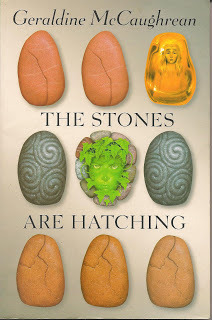 Third on my list is Geraldine McCaughrean's The Stones Are Hatching (Oxford 1999). McCaughrean is one of Britain's most original YA writers: she never repeats herself; but I still think this book stands out from the rest of her work. It's just… peculiar… in the most inventive and satisfying way. Perhaps there are echoes of Alan Garner – or even more, of William Mayne – but it's another black swan, all right. Set in rural England during World War I, while the guns thump and crump just across the Channel in France, young Phelim wakes up one morning to discover that his world is turning upside down. The stove has been pushed against the door - 'the whole massive, five-door, cast-iron range' – the kitchen is full of glashans: 'stark naked men and women about as tall as his waist, shaggy and matted with filth' – there's a Black Dog outside, ravening and raging, and the domovoy or house spirit he never knew existed shoves him outside with the information that he – Phelim – is the Jack o'Green who must defeat the Stoor Worm.
Third on my list is Geraldine McCaughrean's The Stones Are Hatching (Oxford 1999). McCaughrean is one of Britain's most original YA writers: she never repeats herself; but I still think this book stands out from the rest of her work. It's just… peculiar… in the most inventive and satisfying way. Perhaps there are echoes of Alan Garner – or even more, of William Mayne – but it's another black swan, all right. Set in rural England during World War I, while the guns thump and crump just across the Channel in France, young Phelim wakes up one morning to discover that his world is turning upside down. The stove has been pushed against the door - 'the whole massive, five-door, cast-iron range' – the kitchen is full of glashans: 'stark naked men and women about as tall as his waist, shaggy and matted with filth' – there's a Black Dog outside, ravening and raging, and the domovoy or house spirit he never knew existed shoves him outside with the information that he – Phelim – is the Jack o'Green who must defeat the Stoor Worm.
It takes Phelim a long time to believe this. Almost too long. Not until he's almost mown down by corn wives:
Phelim swung his sickle. The wheat hissed, the bearded ears fell against his face making him close his eyes. Then the curve of the blade clanged against something hollow and metallic and black.
A woman's rib cage.
No white-clothed beauty this. At close quarters, he could see the rust-red eyes, the adze-shaped chin, the nose as curved as a bill-hook. Her long black skirt was pale with dust, but not the shiny black of her iron upper body. Her long, flue-black, iron breasts had blunted countless sickle blades as she stood amid the wheat, waiting for her victims to blunder into her. She held a long-handled scythe, but she and her sisters had not come to harvest wheat.
Only the reapers.
And with Alexia the young Witch, Mad Sweeney the Fool, and the ever-cheery Obby Oss, Phelim reluctantly sets out to deal with the Worm which the guns of France are gradually awakening from its age-old sleep.
What perhaps all these books have in common is an almost hallucinatory quality, a vision of the world as an unsettling, startling, ever-changing place full of unexpected grotesqueries, dangers and beauties. Do read them. They will enrich your life.
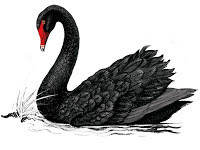
"Only those few black swans I must except, who behold death without dread, and the grave without fear, and embrace both as necessary guides to endless glory…"
Sir Walter Raleigh

But they tend to be memorable.
Here are three examples, all fantasies, all written by highly talented and in some cases famous children's writers – and none of them, I suggest, as well known as they deserve to be.
A Dark Horn Blowing by Dahlov Ipcar (Macdonald 1978)

I hope and believe that some of you will have read this book (because so far in my life I have met only one other person who has). It's based on an old ballad called The Queen of Elfan's Nourrice , in which a mortal woman, stolen to be nurse to the Queen of Elfland's son, laments for her own child from whom she was taken when he was only four nights old:
I heard a cow low, a bonnie cow lowAn' a cow low down in yon fauld;Lang, lang will my young son greetOr his mither take him frae cauld…
Ipcar's book opens with the sound:
I heard a cow lowing, lowing low on the lea – a mournful sound, full of calling. It called me as I stood there at the window listening in the warm twilight of October.
Eben said, "Come to bed, Wife."
But the enchantment is already working. As her husband falls asleep, Nora steals out into the night, leaving her four day old son wailing in the cradle, down through the wet fields to the shore.
A cow's lowing is a sad sound – I had always thought so – but this was more than that. There were words crying in the sound. Almost a song:
Come Nora!Come Nora!You must come!You must come with me!You must come nurse the Erl PrinceIn a kingdom low by the sea.
…It was a small man with a horn, standing by a long black boat there at the edge of the tide. But I never knew when it was that I first saw him, or when he first spoke. The cow's lowing became the dark horn blowing, and then it was too late…
Full, full of enchantment, this tale – told by various voices – follows the path of Nora, trapped in the Erl Queen's kingdom, her husband Eben who believes she has drowned, her son Owen, raised by the only woman his father can find to feed him – the witch Bab Magga, and Eelie, the Erl-Prince himself.
Dahlov Ipcar the author, who was born in 1917, is an artist who has written and illustrated many other books for children. She currently lives in Maine and is still painting. You can see examples of her work at her website here. I don't believe her other three YA novels are in print, but I would love to read them.
Second of my three examples is Seaward by Susan Cooper (Bodley Head 1983, Puffin 1985)
 Though Susan Cooper is best known for 'The Dark Is Rising' sequence of YA novels, in my opinion 'Seaward' outshines them all. It's simply one of the strangest, most haunting fantasies I've ever read.
Though Susan Cooper is best known for 'The Dark Is Rising' sequence of YA novels, in my opinion 'Seaward' outshines them all. It's simply one of the strangest, most haunting fantasies I've ever read. After his mother is killed, a boy called Westerly goes travelling seawards through a mysterious world to find his father - while Cally is a girl whose parents, one after the other, have left her, heading west to the sea themselves in a car driven by a mysterious woman with silver hair. And then Cally begins to hear singing in the empty house… 'rhythmic waves of melody repeated again and again.' The voice sounds like her mother's, but no one else can hear it.
Cally washed, pulled on a shirt and some jeans, went back into her parents' room – and then all at once the singing was back… changed… to a pattern of hammer-blows, beating at her ears. Cally wheeled about, her hands up in defence, terrified.
"Ma! Ma!"
It was instinctive, a cry for help. Where are you? I need you, I don't know what to do, where have you gone? Ma, Dad, I can't do without you, you've always been here, come back, come back…
On this note of unbearable grief, Cally is propelled, like Alice, through the cheval glass in her mother's room and into the same world where Westerly is… a world where god-like figures play chess with mortals, where the bones of dead fish call out 'in a thin high scream shrilling like a cicada' to warn of danger, a world where Cally and Westerly are befriended by a creature like a silver mosquito three feet high, or pursued by The People who come to life when the sun touches them but change to stone at night:
All round the house, out at the edge of the trees, the massive stone figures had been standing in a silent ominous line. Now the sun was going down, and the shadow of the trees had overtaken them – and where they had stood was a long unbroken barrier of rock.
After many strange adventures, Cally and Westerly follow a path beside a small river leading towards the sea, and the path merges with a stone paved road:
And the road was filled with people, walking. …There was no sound but the song of the birds and the slow-speaking river, and not one of the figures walking down the road spoke to any other…
Finally, at the sea, under the eternal sweeping beam of a lighthouse, Cally and Westerly come to their journey's end. It's a moving and wonderful exploration of life, death and grief.
 Third on my list is Geraldine McCaughrean's The Stones Are Hatching (Oxford 1999). McCaughrean is one of Britain's most original YA writers: she never repeats herself; but I still think this book stands out from the rest of her work. It's just… peculiar… in the most inventive and satisfying way. Perhaps there are echoes of Alan Garner – or even more, of William Mayne – but it's another black swan, all right. Set in rural England during World War I, while the guns thump and crump just across the Channel in France, young Phelim wakes up one morning to discover that his world is turning upside down. The stove has been pushed against the door - 'the whole massive, five-door, cast-iron range' – the kitchen is full of glashans: 'stark naked men and women about as tall as his waist, shaggy and matted with filth' – there's a Black Dog outside, ravening and raging, and the domovoy or house spirit he never knew existed shoves him outside with the information that he – Phelim – is the Jack o'Green who must defeat the Stoor Worm.
Third on my list is Geraldine McCaughrean's The Stones Are Hatching (Oxford 1999). McCaughrean is one of Britain's most original YA writers: she never repeats herself; but I still think this book stands out from the rest of her work. It's just… peculiar… in the most inventive and satisfying way. Perhaps there are echoes of Alan Garner – or even more, of William Mayne – but it's another black swan, all right. Set in rural England during World War I, while the guns thump and crump just across the Channel in France, young Phelim wakes up one morning to discover that his world is turning upside down. The stove has been pushed against the door - 'the whole massive, five-door, cast-iron range' – the kitchen is full of glashans: 'stark naked men and women about as tall as his waist, shaggy and matted with filth' – there's a Black Dog outside, ravening and raging, and the domovoy or house spirit he never knew existed shoves him outside with the information that he – Phelim – is the Jack o'Green who must defeat the Stoor Worm.It takes Phelim a long time to believe this. Almost too long. Not until he's almost mown down by corn wives:
Phelim swung his sickle. The wheat hissed, the bearded ears fell against his face making him close his eyes. Then the curve of the blade clanged against something hollow and metallic and black.
A woman's rib cage.
No white-clothed beauty this. At close quarters, he could see the rust-red eyes, the adze-shaped chin, the nose as curved as a bill-hook. Her long black skirt was pale with dust, but not the shiny black of her iron upper body. Her long, flue-black, iron breasts had blunted countless sickle blades as she stood amid the wheat, waiting for her victims to blunder into her. She held a long-handled scythe, but she and her sisters had not come to harvest wheat.
Only the reapers.
And with Alexia the young Witch, Mad Sweeney the Fool, and the ever-cheery Obby Oss, Phelim reluctantly sets out to deal with the Worm which the guns of France are gradually awakening from its age-old sleep.
What perhaps all these books have in common is an almost hallucinatory quality, a vision of the world as an unsettling, startling, ever-changing place full of unexpected grotesqueries, dangers and beauties. Do read them. They will enrich your life.

"Only those few black swans I must except, who behold death without dread, and the grave without fear, and embrace both as necessary guides to endless glory…"
Sir Walter Raleigh
Published on September 09, 2011 02:05
September 1, 2011
Fairytale Reflections - "Happily Ever After"
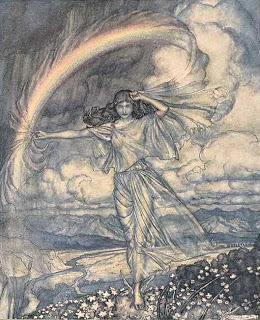 Oral storytelling necessitates a framework. Anyone who's tried singing or storytelling or in any way performing, for that's what it is, in a crowded space, knows that you have to call for attention before you can begin. That's why Shakespeare's plays often begin with a prologue – a man standing on the stage to deliver a speech about the background to the drama, or a couple of minor characters loudly joking and quarrelling, or a shipwreck with lots of dramatic sound effects – something that won't matter if you miss half of it, something to shut the audience up and make them settle down and pay attention.
Oral storytelling necessitates a framework. Anyone who's tried singing or storytelling or in any way performing, for that's what it is, in a crowded space, knows that you have to call for attention before you can begin. That's why Shakespeare's plays often begin with a prologue – a man standing on the stage to deliver a speech about the background to the drama, or a couple of minor characters loudly joking and quarrelling, or a shipwreck with lots of dramatic sound effects – something that won't matter if you miss half of it, something to shut the audience up and make them settle down and pay attention. A song will begin with a chord or a run of notes upon the harp or guitar, and the beginning of a story is signalled by a stock phrase: 'Once upon a time'. It's a device to arrest the listener, and to locate the story, placing it in a mythic but relevant past. 'Il etait une fois', or 'Es war einmal…'or 'It wasn't in my time, or in your time, but once upon a time, and a very good time it was…'
The device is common to so many languages, I think people must have been beginning stories in this way since paleolithic times. I'm told classical Arabic stories begin: There was, oh, what there was or what there wasn't, in the oldest of days and ages and times…' North American Mi'kmaq stories begin, 'Long ago, in the time of the Old Ones…' Czech and Hungarian stories begin, 'Once there was, once there wasn't…'
And this sort of opening phrase sends a subtle but distinct message to listeners. It says: 'Pay attention!'; but it also says: 'Though this is going to be amusing or stirring or exciting, it's probably not true.' It says, 'This is a story. Sit back and listen.'
And so the room hushes, the people attend, the storyteller spins her tale. There's a real physical element to listening to a story. It's like going on a roller coaster. It's not like reading, where everything happens at exactly your own pace, and you can glance ahead, or turn back to check on something, or put the whole book down for ten minutes to make a cup of coffee. Listening to a story, you are in the power of the storyteller. You must keep still and listen carefully not to miss a word. You watch her face as she frowns or smiles. The flash of her eyes, her gesturing hands. You don't know what is coming next, or even how long the story is going to be. For she on honey-dew hath fed, and drunk the milk of paradise. Everything is a surprise.
Some stories are very short. Some are very long. Some divide into almost separate segments, picaresque narratives in which one thing follows upon another with the most tenuous of links. The princess and the prince are married, they become king and queen. The audience draws breath - but that's not the end. The storyteller is still speaking. The king goes to war, leaving the young queen in the care of his old mother. But the old woman hates her, and so, when the queen gives birth to her first child, the old woman orders it to be killed and the blood smeared over the queen's clothes so that everyone will think she has killed her own child…
No, it's not the end yet.
And so, when the end does come, it is often signalled with another stock phrase, to show that the show is over. Puck delivers the epilogue; Rosalind steps out of the framework of the play to flirt with the audience about their beards. Fairytales conclude with the words 'and they all lived happily ever after' – or sometimes, 'they all lived happily till they died' – or even, 'if they haven't died yet, they are living there still'…
It's getting more conscious and ironic, isn't it?
Fairytales, contrary to what people suppose, are not naïve. Their very existence floats in the relationship between narrator and audience. Indeed it is naïve to imagine that 'happy ever after' – much derided as a banal or smug or thoughtless conclusion – was ever intended as much more than the signal that the story is over. The bite of narrative has been chewed and swallowed: the show is done. The listeners can get on with drinking beer, eating, bargaining, gossiping, telling rude jokes, or heading off outside for a piss, or trudging home to their own difficult wife, husband or parent. Beginnings are important, endings less so, because the stock phrases that signal the end of a fairytale do not call for attention, but dismiss it. They don't place the story in the mythic past, they undermine it. 'If they haven't died yet, they are living there still' (but how likely is that?). And so fairytale endings are far more varied than beginnings: in fact they can be purposely surreal and disconnected.
'They found the ford, I the stepping stones. They were drowned, and I came safe.'
'This is a true story. They are all lies but this one.'
'There runs a little mouse. Anyone who catches it can make himself a fine fur cap!'
'Snip, snap, snout – this is the end of the adventure.'
'And when the wedding was over, they sent me home in little paper shoes over a causeway covered in broken glass'.
Dear readers – here is the end of the Fairytale Reflections series.
Unless I change my mind.
Picture credit: Fairy by Arthur RackhamShe may actually be Iris with her rainbow scarf. She hasn't much to do with the post, but I like her.
Published on September 01, 2011 23:59
August 26, 2011
Fairytale Reflections (32) Penny Dolan

My friend Penny Dolan and I have much in common. Not only is she a Yorkshire lass like me, she's a storyteller as well as a children's writer, and we share a delight in that feistiest of fairytale heroines, the beautiful and dauntless Lady Mary from 'Mr Fox'. We're also both members of 'The History Girls', a new blog devoted to the discussion of historical fiction. On top of that, the tale she has chosen for this week's Fairytale Reflection has a physical marker which can be found no more than a handful of miles from where I live.
Penny is the author of many picture books and fairytale retellings for younger children, as well as longer books for junior readers. Notable among these is 'The Third Elephant', a lovely tale of a small wooden elephant who longs to see more of the world than his dusty mantelpiece:
When night came, the small elephant looked at the empty pool of moonlight. He thought about what the mouse had told him: wish for what you want, wish for what you dream about. 'I wish', he thought, as hard as he could, 'I wish I could see the white palace again.'
His wish begins to come true when the house is demolished. In the classic tradition of change coming to discarded toys, the little elephant is thrown out of the window and falls into the hands of a young girl, Sara, who is on her way to play the flute in a concert. The little elephant calms her nerves, so when her older sister Nita becomes panicky about a cycling trip to India, Sara pops the little elephant into Nita's bag – and the adventures begin in earnest: plenty of them! 'Charming' is an adjective which can sometimes be suspected of carrying the subtext 'trivial', but this is a book which is both truly charming and seriously involved with the fears and uncertainties of childhood.
 As, in many ways, is Penny's latest novel, 'A Boy Called M.O.U.S.E.' I absolutely loved this book – so much so that I just have to show you the cover of the paperback, with a magical illustration by David Wyatt. Here you can see the hero, Mouse, balancing above the skyline of Victorian London, on his journey to rediscover his lost foster-mother and find out the secret of his birth.
As, in many ways, is Penny's latest novel, 'A Boy Called M.O.U.S.E.' I absolutely loved this book – so much so that I just have to show you the cover of the paperback, with a magical illustration by David Wyatt. Here you can see the hero, Mouse, balancing above the skyline of Victorian London, on his journey to rediscover his lost foster-mother and find out the secret of his birth. Mouse is a modest, thoughtful, but adventurous boy who, like his little namesake, has a talent for scurrying up walls and climbing along beams, which stands him in good stead when he finds temporary haven and work behind the scenes in the Albion Theatre, run by the charismatic actor-director Hugo Adnam.
A couple of years ago when my daughter was studying aspects of the Victorian theatre at university, I took some sneaky peeks at some of her books, but Penny has really brought the dry bones to life for me. I'm particularly struck by the two little girls Mouse meets on the street after midnight:
Well after midnight, shrill, childish voices woke me. Two small girls appeared around the corner. Rough wool shawls were gathered over their trailing gauzy skirts. Giggling and singing, the little girls danced over cracks in the pavement and hopped along the kerb, their legs thin as those of foals on a farm. Tinsel strands sparkled in their hair, and their cheeks were smeared with paint.
Who are they? Child actors who've been playing fairies in the latest theatrical extravaganza, working till all hours, and in danger as they head home on the late-night streets of the city.
Penny describes 'A Boy Called M.O.U.S.E' as 'a historical fairy tale', which sums it up excellently. It's beautifully written, carefully researched, and there is indeed a happy ending: although it is nuanced, thoughtful and by no means inevitable. The book is also full of allusions to Victorian fiction, plays, and old legends about larger-than-life wanderers on the old roads of England - including this one, which is very old indeed.
Wayland's Smithy: a tangle of tales...

Wayland's Smithy
All that was needed, so people said, was a single coin placed on a stone beside your tethered horse. Have faith, leave the horse there all night and when you came back next morning, your steed would be newly shod and the coin gone.
Though the nights of magical shoeing are surely long past, the ancient burial mound known as Wayland's Smithy is still there on the shoulder of chalk downland, and the place with its tangled tale, haunts me.
I first saw the Smithy on a day so wet that froglets skittered from the path into overfull ditches and milky water ran down the cracks in the chalky clay.
The rain gods had only paused. By the time we had reached the crest of the ridge, a downpour had began. Thunder rolled around the hills and as we approached Wayland's Smithy, the huge, dark clouds above were lit with streaks of lightning.
The long barrow lies off the track. We pushed through wet bushes and came to it, covered in grass and surrounded by grove of trees. Several ancient stones formed the gateway.
With the storm raging, the moment felt as if the past was only a shadow away. It was impossible not to think of the many feet that had passed along the Ridgeway and made the path, with or without horses to be shod. Did they all wonder at the mysterious mound or the strange white horse spread across the hillside nearby? Did they seek shelter in the small wood?
However, the helpful smith of the legend does not match entirely happily with the Norse version of Wayland the Smith.
Wayland, or Volund, had been apprenticed to the dwarves of the Icelandic Mountains, He was one of the three sons of Wade, the king of the Finns. Out hunting, the brothers found three beautiful swan maidens, seized their feathered robes, and made them their wives. When the three sisters discovered their hidden feathers again, they flew away to freedom.
The two older brothers went searching for their wives, but the desolate Wayland stayed working at his smithy, sure that his beloved wife would return for the golden ring he was keeping for her and all the other treasures he was creating.
Soon rich men grew greedy for Wayland's skills, King Niduth of Sweden more than any. Wayland was lured to his castle, crippled, imprisoned on an island and made to forge endless objects for the king. So dazzling were the treasures and so great the family's pride that they forgot to be wary of their prisoner.
The two princes visited Wayland, who treated them kindly until they mocked him. Enraged, he beheaded them both and fashioned a set of dreadful gifts for the royal parents. The princely skulls became golden goblets, the eyes glittering gems from their eyes, and their pearly white teeth made a necklace for the queen their mother.
Meanwhile, the princess, jealous of her brothers, visited Wayland, bringing a golden ring for him to mend. Recognising the stolen ring as that made for his lost wife, he cruelly seduced the princess, leaving her with child. Having sent her and the horrific treasures back to the palace, Wayland strapped on a pair of mechanical wings, rose into the sky and flew away.
It is not quite clear how this tale links up to the burial mound, although the ancient site may have been given its new identity by Anglo Saxon invaders.
Certainly the tale travelled and adapted. One version claims that Wayland's wings brought him to the mound, and that the Norse hero Sigurd brought his horse there to be shod. Some say that explains the white horse set in the chalk, who leaves the hillside once every hundred years and gallops across the sky to the smithy to be shod.
To me, this tale is loaded with contrasting images – the stolen skins of the swans, the broken wedding ring, the patient and desolate waiting, the greed of the powerful, the Samson-like captivity, the image of those awful golden chalices, and thee Daedulus-like wings – and they all make the tale of Wayland unforgettable. One cannot love or admire him, yet there is something enigmatic about his tale and about the unbound rage that creates such dreadful treasures.
The crippled smith's name is mentioned in Beowulf, in the poem Volundarkvitha (part of the poetic Edda) as well as in Chaucer's writings, in Kipling's 'Puck of Pooks Hill', and in 'Kenilworth'. He is said to be a fore-runner of St Clement, patron saint of blacksmiths and both have feast days in November.
Why does the Wayland story matter to my writing? When I wrote my novel 'A Boy Called Mouse', I came to a section where my Mouse needed to have a place where he could rage and let out all the anger he felt. The pattern of his world had shifted dreadfully and he needed time in the wilderness to move out from his terrible grief, and renew his hope for his quest.
The image of that ancient site came into my head and the long path running alongside, and the wild storm overhead. So I created a "tramping man", a character called Wayland. He is not a man who would put out my young hero's eyes, but a wise kindly figure who makes Mouse to walk and walk and keep on walking along the high ridge of ground while a storm rages around them, almost Lear-like. Wayland. This agonising march moves Mouse out of his despair and sets him free for his future. The tales don't fit easily together but for me, something matched.
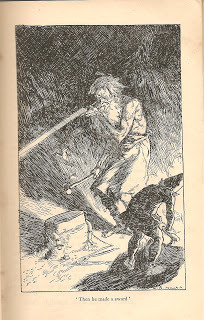
'Weland forges the Sword' - by H R Millar, from 'Puck of Pook's Hill'
Published on August 26, 2011 00:34



